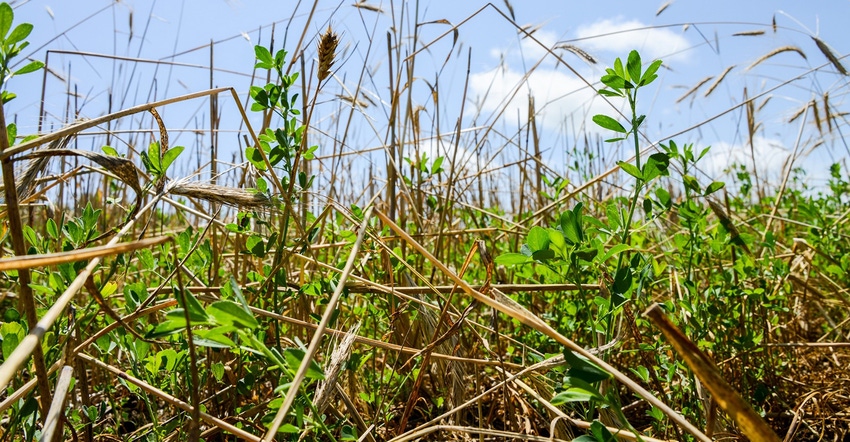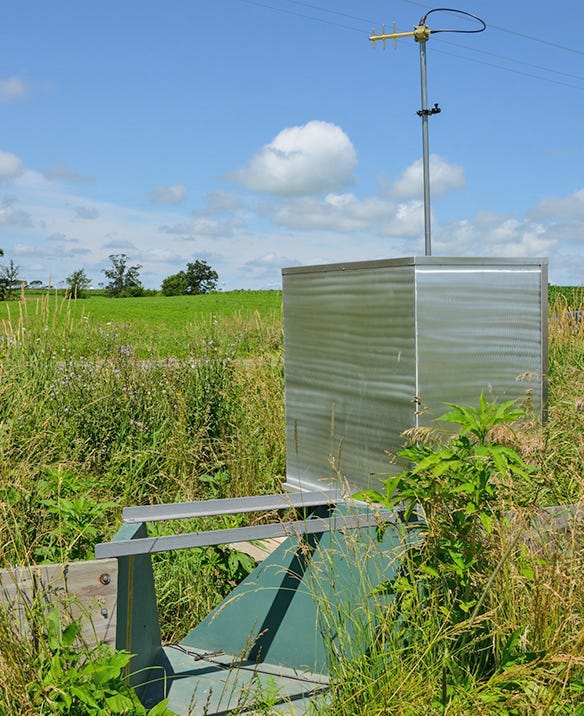November 2, 2018

By Steve Werblow
Corey Leis’ alfalfa looks lush in the summer, but last spring, the new stands didn’t look like much. The little alfalfa plants, pushing up in no-tilled rows, were overshadowed by tall cereal rye that had overwintered as a cover crop. Heavy on rye, the first cutting was better-suited for the farm’s 50 Hereford-cross beef cows or 80 Holstein steers than its 375-head milking herd, admits Leis, who operates the farm with his father near Cashton, Wis.
But the same 10% to 12% slopes that inspired the Leis family to switch to no-till on their 1,700 acres of cropland by the 1990s has convinced them of the importance of cover crops to minimize erosion. The benefits of fall-seeded rye in helping build soils — boosting soil health even on fields that will benefit further from three years in alfalfa — clinched the deal.
“You’ve got all that extra root growth right there that decomposes and helps bring up our organic matter in our soils,” Leis says.
Leis and his father broadcast rye after harvesting corn silage, letting it establish a thick stand over the winter. In the spring, they no-till alfalfa into the standing cover crop.
“It looks like you just went through and disked it all up, but within about a week’s time, that rye is back and just as healthy as can be,” Leis says. “So you’ve got a quick cover, faster than oats or any other crop, and then it’s there to help protect from erosion. We try to get that crop off as quickly as we can and let the alfalfa come right on through.
“It’s a little slow-looking at first, but once you get that first crop off and give it about a week, that alfalfa just comes right through. In a normal year, we’ll get two more cuttings of hay. They won’t be super-big cuttings, but they’ll be nice.”
Water quality challenges
Reducing runoff helps build soil moisture reserves that come in handy during summer dry spells, Leis notes. It also protects water quality in the Jersey Valley and the Kickapoo River watershed from water-borne sediment and nutrients — a major problem in the region. Healthy soils are more effective at fighting runoff and erosion. They were put to the test this year with more than a foot of rain in a single August night, and came through in surprisingly good shape.
 CONSERVING RESOURCES: Corey Leis is committed to reducing the runoff of nutrients and soil into the Kickapoo River watershed.
CONSERVING RESOURCES: Corey Leis is committed to reducing the runoff of nutrients and soil into the Kickapoo River watershed.

“The health of the streams and rivers in the Upper Midwest is important to local communities as well as to water quality in the Great Lakes, and landowner and farmer actions to reduce the amount of runoff, nutrients and sediments that leave their farms matter at multiple scales,” says Sarah Lehmann, team leader for the National Aquatic Resource Surveys (NARS) program in the U.S. EPA’s Office of Water.
“Corey and his family have taken their commitment even further by participating in Wisconsin’s Discovery Farms program, providing hard data on the impacts of some of their conservation practices that helps guide their on-farm decisions into the future,” she says.
NARS researchers found that 53% of the river and stream miles in the Upper Midwest — which covers two-thirds of Wisconsin, much of Minnesota and nearly all of Michigan — were rated “poor” due to high levels of phosphorus, and just 38% were rated “good” for P. High nitrogen levels caused 40% of the region’s river and stream miles to be rated “poor” and 38% “good,” and macroinvertebrate populations rated 34% “poor,” 29% “fair,” and 37% “good.”
Strip cropping saves
In 2010, a University of Wisconsin Discovery Farms team installed a water quality monitoring site at the edge of a 10-acre parcel that Leis plants in alternating 80- to 90-foot-wide contour strips of corn and hay. Extension personnel collected data for years on water, sediment and nutrients leaving the farm. They included the data in their statewide water quality research as well as in a recent analysis of runoff from urban and farm sources in the Jersey Valley watershed.

MONITORING STATION: This UW Discovery Farms monitoring station recorded the movement of nutrients and sediment off one of Corey Leis’ fields. Thanks to no-till and strip cropping, runoff was minimal.

Leis is a big believer in the importance of data in highlighting key contributors of runoff and identifying practices that work.
“Without this data, we are just guessing, and that can be costly,” he says.
The Jersey Valley watershed report is available online at the Wisconsin Discovery Farms’ website. EPA and its partners across the country are beginning a new round of sampling for the next NARS report. Meanwhile, farmers can access data from the most recent NARS reports on EPA’s website.
Better water retention
Building soil organic matter is a huge help in both wet years and dry ones, Leis says.
“Your soil can just hold a lot more water when you keep plants and root growth in there all the time, all year-round,” he says. “It helps you through the summer months when it can get dry for a two- or three-week period. The crops just stay healthier-looking all around, and when it does rain, the soil captures the water so it’s there at that time when it’s a little dry.”
Healthy soils that can absorb and retain water also help fight runoff and erosion, Leis adds. He says those abilities have been put to the test more frequently in recent years on his farm.
“The rains we have anymore, it’s not just a small amount of rain; they’re large amounts of rain in a short period of time,” he says. “It’s hard for the soil to contain all that water in such a short time, so you get a lot more runoff. The cover crops slow it down, and we don’t get the ditching that some people maybe would with conventional tillage.”
Sue Tull, project coordinator for the Conservation Technology Information Center in West Lafayette, Ind., points out that cover crop users across the country report greater soil moisture retention where they plant cover crops, which is especially valuable in dry years.
“For the past five years, we and the Sustainable Agriculture Research and Education program have been surveying farmers about their use of cover crops, and one of the benefits that comes up in each survey is the improvement in soil moisture retention,” Tull says. “That was especially true in 2012, when drought dragged down crop yields. Survey participants reported an average corn yield boost of 11.3 bushels per acre and an average increase of 5.7 bushels in soybeans where they used cover crops compared to where they didn’t. We’ve seen yield improvements in both corn and soybeans every year in the survey, but it’s notable that the highest boost was during the driest year.”
The CTIC/SARE cover crop survey reports are available online.
Werblow writes for the Conservation Technology Information Center.
You May Also Like




